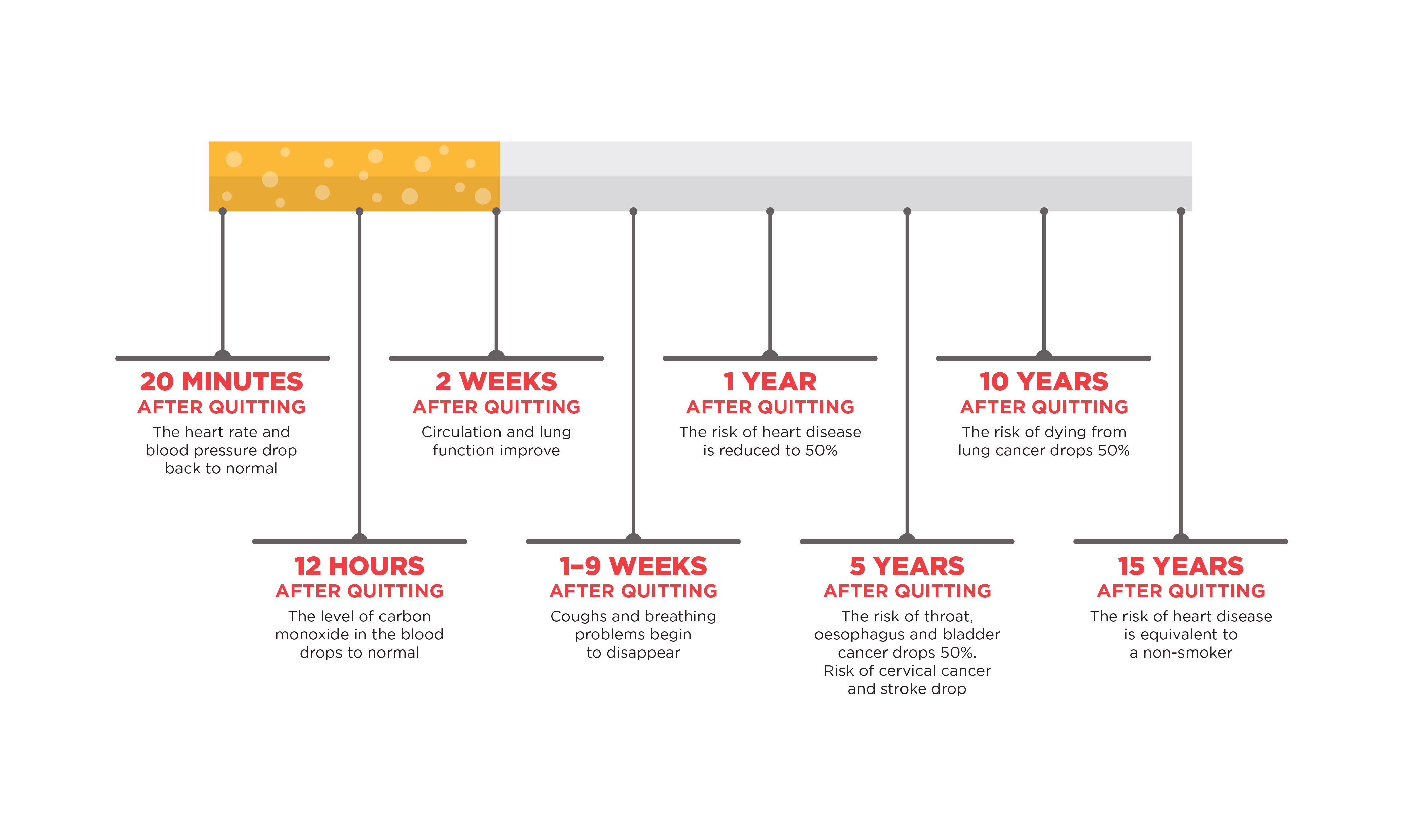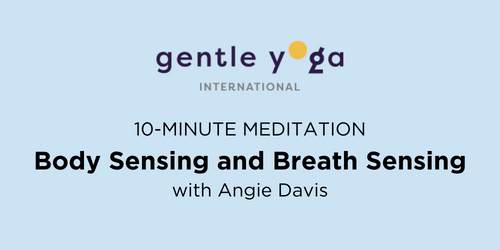Module 4
Smoking and Nicotine Cessation
It took time for you to learn to smoke and use nicotine... and it will take time for you to learn to live without it. You are stronger than your addiction!

OVERVIEW
By the end of this module, you will have met the following goals:
Goal 1: Learn about the advantages of quitting
Goal 2: Learn about the different types of nicotine addiction and your common triggers
Goal 3: Learn to develop a Quit Plan
Goal 4: Exercise three times this week and continue the home walking program
Goal 5: Take Action to understand your dependence on nicotine, to determine your motivations for quitting and to build a quit plan that will help you succeed in being smoke and nicotine free
General Information
Quitting smoking and other inhaled nicotine use is one of the best investments in your future. It is never too late to quit.
When you stop smoking:
- you improve your health and increase your life expectancy,
- you lower your risk of 12 types of cancers,
- you slow the progression of your lung disease, and
- you reduce the effects of second-hand smoke to those around you.

There is no perfect time to quit, but some times are better than others.
If you feel motivated today, then it’s a good day to quit. Other good days might be New Year’s Day, National Non-Smoking Week (the third week of January), your birthday or when a friend or relative decides to quit, too.
It is more challenging to quit during times of high-stress, low-mood or high contact with other smokers. These times require more physical and emotional energy.
20 minutes after quitting
Your heart rate and blood pressure returns to your normal
12 hours after quitting
Your blood carbon monoxide level returns to normal
48 hours after quitting
Your sense of smell and taste begin to improve
2 weeks after quitting
Your circulation and lung function begin to improve
1 to 3 months after quitting
Your cough and breathing problems begin to improve
1 year after quitting
Your risk of heart disease is reduced by half
5 years after quitting
Your risk of throat, esophagus or bladder cancer is reduced by half. Your risk of cervical cancer (in women) and stroke drop. Your risk of having a stroke is the same as for a non-smoker
10 years after quitting
Your risk of dying from lung cancer is reduced by half
15 years after quitting:
Your risk of heart disease becomes equal to that of a non-smoker
Understanding and addressing addiction
Addiction is complex. Understanding your addiction and knowing your triggers can help you plan for the challenges of quitting, as well as appreciate and celebrate your steps to success. To address addiction, consider the three links that bind you to smoking and nicotine use.
Physical addiction
Nicotine is an addictive substance. Nicotine releases a chemical called dopamine in your brain that makes you feel good. Your body craves feeling good. When that feel-good response to nicotine wears off after a long night’s sleep, a full day of work or a flight, your body lets you know that it's time for more nicotine.
People with a strong physical addiction to nicotine may benefit from nicotine replacement therapy (NRT) to help them gradually overcome their dependence.
Mental addiction
Smoking is often associated with daily routines, for example having a cigarette with a cup of coffee, after a meal, or when watching the news. The connection that ties activities to smoking is a form of mental addiction. Mental addiction also refers to the emotions that prompt your desire to smoke - stress, loneliness or even joy.
Changing your daily routines and finding different emotional coping strategies help to minimize mental addiction to nicotine.
Social addiction
Certain social situations can lead people to smoke together. This may be a way to connect with a new social group, a common thread that connects you to old friends, or an end-of the day way to relax with a friend or partner.
Social support is equally important when you quit smoking. Finding people who support you in quitting, and talking with them regularly, has helped many to be successfully in their efforts to quit.
Determine your dependence on nicotine by completing the Fargerstrom Tolerance Scale in the Take Action section.
Common triggers
Know your triggers: mornings, coffee, watching television, driving, stress, phone calls, boredom, meals, alcohol, a comfortable chair, loneliness, gatherings. Can you name some more?
Understanding when and why you smoke or use nicotine is an important step in the quitting process. The Take Action section in this module allows you to track your daily habit, as well as your triggers.
Making a Plan to Quit
First, consider when and why you smoke or use nicotine. Try to recognize your trigger(s). Are they physical, emotional and/or social. Listing your reasons for smoking as well as your motivations for quitting is a healthy start to a successful quit plan.
Make a plan
Choose two or more proven quit-smoking methods. Here are some options:
- List your motivations for quitting
- Find support: in-person, telephonic or online support
- Get the support of family and/or friends, or a certified respiratory educator
- Use non-prescription nicotine replacement therapy (NRT) like nicotine gum, lozenges, inhalers or patches
- Ask a member of your healthcare team about prescription medications to help you quit
- Avoid places where you habitually smoke and people that you habitually smoke with (for some time)
Using both NRT and a counselling program (group or individual) increases your likelihood of quitting permanently. Talk with your healthcare provider, pharmacist or certified respiratory educator about programs and resources in your area.

The Canadian Lung Association is one of the partner organizations behind Smoke Free Curious, a site that features a wide range of proven tools and resources to help you quit.
- Find resources in your area on the Quit Map
- Order free NRT
- Speak to a quit coach by calling 1-866-366-3667 (toll free)
- More tools and resources
Pick a day
Quitting is a personal challenge. Whether you decide to gradually cut back or quit all in one day ("cold turkey"), the choice is yours. There is no perfect way or perfect day. Consider low-stress times when you can avoid physical, mental or social triggers. Circle the day on your calendar and do not accept reasons to back out.

Be prepared
- Nicotine suppresses appetite. Be prepared with healthy snacks.
- Nicotine relieves stress, but so does walking, singing or humming.
- Nicotine, like caffeine, is a stimulant. Be ready for low moods and low motivation. Remember this is temporary.
- Get rid of all nicotine items in your home, car and work environment
- Wash your ashtrays, clothes and jackets to get rid of the smell.
- Keep distractions for your mouth, hands and mind available while at home, in the car and at work.
- Sugar-free gum and candies, toothpicks and/or straws.
- Puzzles, puzzle books, fidget items and hobbies can occupy your thoughts and hands.
- Choose your ways of coping, like positive self-talk, calling a friend, listening to music or using a relaxation website or app.
- Reward yourself every time you defeat a craving.
Celebrate your successes
All milestones are monumental.
- Celebrate 1 day, 3 days, 1 week
- Celebrate 3 weeks. That’s 21 days of being a nicotine free, long enough to break a habit!
- Celebrate 3 months. That’s a big one as it's the average timeframe for people to truly quit.
- Every day that you are a non-smoker or non-nicotine user, is a day you should celebrate.
If you slip up, don't give up. It can take many attempts to successfully quit smoking. Consider these attempts trial runs. Be kind to yourself and don’t quit on yourself. Again, you are stronger than your addiction.
Think positive
Look for the good in situations, even the slip-ups. You have learned something that you should plan ahead for, or something that you should avoid. Revise your quit strategies and try again. Plan for a reward with your unspent smoking dollars.
Get some extra support
Have a quit buddy to join you in quitting; or select a friend who has quit to support you through challenging times. Choose your support people carefully. Make sure your friend understands that criticism is not helpful when you are trying to quit.

Walk it off
Adding exercise helps to calm cravings and calm "slip-up guilt".
Review your motivations for quitting and renew your commitment to yourself.
Visit Smoke Free Curious to find a wide range of free tools and resources to help you quit.
EXERCISE
Your steps to success
- If you have a pulse oximeter, check your oxygen saturation and heart rate. If they're normal for you, plan to exercise with us.
- Have you taken your long-acting controller inhalers? Should you take your quick-acting reliever inhaler before exercising?
- Are you assessing your symptoms daily?
- Is your oxygen set correctly for exercise?
- A little breakfast goes a long way when you plan to exercise.
- Quickly dismiss cravings using one of the 5D's - Distract, delay, deep breathe, drink water, discuss.
- Be happy that you're working your way through module 4! You are halfway through!
Be happy! You are working your way through Module 4, and halfway to the finish line!
Gradually increase how long you walk, cycle or swim. Below is a guide to help you increase your walking time.
Exercise program
Week 1
5 minutes, 5 times per day
Weeks 2 & 3
10 minutes, 3 times per day
Weeks 4 & 5
15 minutes, 2 times per day
Week 6
20 minutes, 1 time per day
Week 7
25 minutes, 1 time per day
Week 8
30 minutes, 1 time per day
Relaxation, Meditation and Better Breathing
Reinforcing relaxation and diaphragmatic breathing.

Youtube supports many free Mindful Meditation and Better Breathing videos to promote effective breathing techniques, as well as mood, motivation, relaxation, stability, clarity and sleep enhancement. The Canadian Lung Association does not endorse the use of any particular or specific website or channel for meditation and relaxation. Sites listed are suggestions only.
TAKE ACTION
Motivations and strategies for smoking and nicotine cessation
Take the survey
Take this survey to better understand your smoking and nicotine dependence.
Calculate your savings
Calculate how much you can save when you quit smoking.
Keep a diary
Track your smoking/nicotine usage with this smoking diary.
Motivations and strategies
Discover motivations and strategies to help stop your smoking and nicotine use.
Breathe Better with the Respiratory Care Program
Sun Life and Online Pharmacy, provided by Pillway*, have partnered to offer you and your dependents the Respiratory Care Program. You'll receive 1-on-1 support to help you get back to doing the things you love while breathing easier. The program is available for people living with asthma and chronic obstructive pulmonary disease (COPD), and at no cost.
Read more about the Respiratory Care Program and our collaboration with Sun Life.
Program not available in Quebec
Make life more convenient with Online Pharmacy
Online Pharmacy, provided by Pillway*, is an online pharmacy that makes life more convenient by changing the way you get your medications. Offering fast and free delivery, pharmacist support and medication management.
Read more about Online Pharmacy and our collaboration with Sun Life.
*SHG Pharmacy Inc. and SHG West Pharmacy Inc., doing business as Pillway pharmacies, are partially owned by Simpill Health Group Inc. For your information, and as a point of disclosure, Sun Life Assurance Company of Canada has partial ownership in Simpill Health Group Inc.
FEEDBACK
Tell us what you think
Modules
Introduction · Module 1 · Module 2 · Module 3 · Module 4
Module 5 · Module 6 · Module 7 · Module 8 · Conclusion

Speak to a certified respiratory educator
Call our Health Information Line at 1-866-717-2673 to speak to a certified respiratory educator. You can also email info@lung.ca.
BreatheSTRONG Program: Medical Disclaimer
Before you begin the BreatheSTRONG program, please read and agree to the medical disclaimer.
Medical Advice Disclaimer, Disclaimer of Warranty and Limitation of Liability
Please read this document carefully. The Canadian Lung Association (CLA) strongly recommends that you consult your physician or other qualified healthcare provider before choosing to take part in BreatheSTRONG. You acknowledge that CLA offers no medical assessment, diagnosis, or treatment, and that CLA makes no determination as to whether or not you are physically fit to participate in this program. This program is intended for Canadians living with chronic lung disease, be it obstructive or restrictive in nature. This program is not supervised and therefore not intended for Canadians who are awaiting lung transplant, lung volume reduction surgery or those who have pulmonary hypertension. Certain pre-existing non-respiratory conditions may also exclude you from participating in the exercise portion of this program.
THERE ARE POTENTIAL RISKS INHERENT in your participation in BreatheSTRONG, including, without limitation, worsening of your existing symptoms, an increased load on the heart, episodes of light headedness, fainting, dizziness, pain, chest discomfort, shortness of breath and bone and muscular injury. If you experience faintness, dizziness, pain, or unmanageable shortness of breath at any time while participating in exercise program, you should stop immediately.
CLA and BreatheSTRONG cannot respond to medical emergencies. If you think you have a medical emergency, call 911 immediately.
CLA assumes no liability or responsibility for the use of any information provided by BreatheSTRONG, or for your reliance on this information in place of specific medical advice from a qualified healthcare provider. As is, the health information content provided in this program is current, reviewed and approved by qualified healthcare professionals. To the maximum extent permitted by applicable law, CLA disclaims all liability for any errors or other inaccuracies in the information provided. In no event shall CLA be liable for damages of any kind, including but not limited to direct, indirect, special, consequential, or other monetary damages in connection with your use of or reliance upon information provided by BreatheSTRONG.
By following this program, you acknowledge that you have read, understand and agree to abide by the above Medical Advice Disclaimer, and Disclaimer of Warranty and Limitation of Liability.
